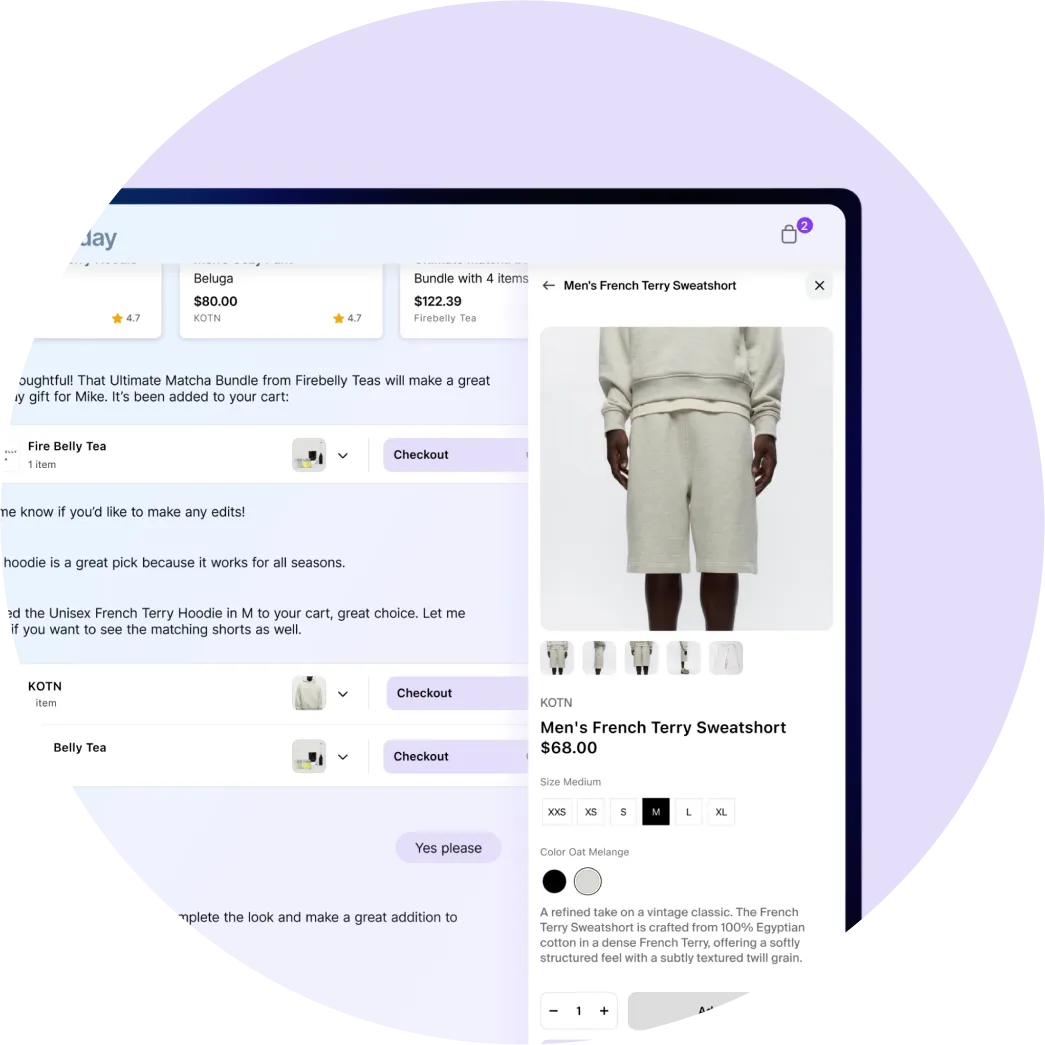Shopify Agentic Commerce: AI-Driven E-Commerce

In recent years we have witnessed waves of so-called “announced revolutions”: the metaverse, social commerce, and even the commercialization of digital artworks through NFT shopping. Many promises, but few large-scale real implementations. Today, however, with the concept of Agentic Commerce, we can perceive a substantial shift.
Companies like Amazon and Walmart have already been testing “buy-for-me” features that allow AI to make purchases on behalf of consumers. This is no longer about chasing a trend, but about observing how artificial intelligence is changing the very role of the user in the purchasing process. And Shopify, with its new Agentic Commerce architecture, is positioning itself as a pioneer in this transformation. Shopify’s strategic initiatives in this area highlight its determination not only to keep pace with these developments, but also to lead the evolution, enabling even smaller merchants to take advantage of the opportunities that are emerging.
What is Shopify Agentic Commerce
Agentic Commerce is a new mode of shopping where autonomous AI agents manage the entire purchasing journey for the user, from product discovery to checkout, without the customer having to manually navigate a website. In practice, the role of the user shifts from “active navigator” to “smart delegator.” Shopify enables this experience through three integrated tools:
Shopify Catalog: Provides real-time access to millions of products from various Shopify merchants, with visual media and UI components to display results directly in agentic flows.
Universal Cart: Allows products from multiple Shopify stores to be added to a single shared cart, all managed by the agent.
Checkout Kit: Integrates Shopify’s secure checkout (including Shop Pay) directly into the agentic flow, maintaining branding and compliance (GDPR, PCI DSS) without leaving the conversational experience.
Recognizing the growing importance of AI in retail, Shopify has forged partnerships with major generative AI engines. Particularly significant is the collaboration with OpenAI, which positions Shopify as a search partner within AI-driven shopping experiences. In addition, Shopify is integrating with the AI-powered shopping assistant from Perplexity, further enhancing its capabilities in this space.
Through these tools and partnerships, Shopify supports automated and conversational flows in which an AI agent finds, compares, and purchases products on behalf of the customer. That is, in essence, the definition. But let’s try to understand it more deeply.
Why Shopify Agentic Commerce Changes the Rules
We are not talking about yet another platform that simply “adds” to the existing ones. Agentic commerce does not create a new channel: it transforms the way all channels can be used, because it places an intelligent intermediary between the user and the shopping experience, with Shopify remaining the terminal of the operation. The buyer is no longer forced to type, browse, and manually compare, but can delegate to an AI agent the task of understanding their needs, exploring the best options, composing a universal cart, and completing the purchase. It is a radical paradigm shift, not just a technological update.
Many merchants and e-commerce managers today wonder if this is just another marketing gimmick. In reality, the difference compared to the past is that the infrastructure is already here. Shopify has created three very concrete pillars, as mentioned above: a centralized and structured catalog that makes products immediately readable by AI, a Universal Cart that allows purchases from different stores to be unified in a single flow, and a Checkout Kit that integrates the reliability and speed of Shop Pay into a frictionless conversational experience. It is therefore not about future promises, but an already operational tool that forces brands to ask themselves a key question: will we govern this change, or will we let others define the relationship between our customers and their purchases?
The most interesting—and at the same time critical—aspect is that agentic commerce takes away part of the user’s conscious decision-making power, at least in the form we are used to. If until yesterday the challenge of digital marketing was to capture the attention of a distracted customer across an endless flow of touchpoints, today the real challenge is convincing an AI agent to select our products over others. In other words, we are entering an era where SEO will no longer be focused solely on traditional search engines, but also on the recommendation engines of artificial intelligence, namely AEO and GEO1.
This opens up an entirely new field, where merchants must obsessively curate the quality of their data, the structure of their catalogs, and the consistency of their information. It will no longer be enough to write an appealing description for the human eye: it must also be written for the algorithmic eye. But in the meantime, we can exploit the advantage of knowledge by being among the first to use it and, in practice, refine it over time.
The Importance of a Structured Catalog
Many merchants underestimate the value of a well-structured catalog. They see it as boring, uncreative work, often delegated to supplier databases or third-party services, when in reality it is the very foundation of any form of agentic intelligence. In a world where algorithms will choose what to propose to users, product data will become the true currency of exchange. Imagine an AI agent that must decide which sneaker to recommend to a user who has just said: “I want lightweight shoes, suitable for walking a lot, but with a minimal design.” If your product page is incomplete or inaccurate, the agent simply will not consider you. You will be invisible, even if you have the perfect product for that request. This is why agentic commerce places at its center a new discipline: data-driven merchandising, where the priority is not only to communicate emotions, but to translate those emotions into parameters readable by AI.
From a strategic standpoint, the implications are enormous. Companies that still think of e-commerce only as an “online sales channel” risk becoming completely misaligned. Agentic commerce is not just about digital: it is about how people will live their shopping experience more broadly. It means imagining a world where the customer no longer has to remember to buy coffee, because the AI agent has already done it for them based on past consumption, choosing the most convenient and reliable supplier. It means a world where recommendations no longer come from reviews or influencers, but from a probabilistic calculation that takes millions of variables into account. It is a future where the shopping experience becomes invisible, yet even more pervasive.
How to Get Started with Shopify Agentic Commerce Tools
If you are an e-commerce entrepreneur looking to take advantage of this new technology, here is where to begin:
Request Access: the first step is to work with your development team or with an agency such as HT&T Consulting, to explore the documentation and request access to Shopify’s agentic commerce tools. These tools are currently available in beta or developer preview.
Use the APIs: integrate the Shopify Catalog API to enable seamless product discovery and the Universal Cart to manage items from different stores. This allows your brand to become part of the AI-driven customer journey.
Implement the Checkout Kit: use the Checkout Kit to handle payments. In this way, you can leverage Shopify’s secure, high-converting checkout without having to build a payment system from scratch, directly contributing to your business profitability.
But What Will Happen to the Brand?
Here lies a critical point: agentic commerce risks reducing the power of brands to build a direct relationship with consumers. If it is the AI agent making the choices, what will become of storytelling, emotional branding, immersive experiences? Some argue that the brand will become irrelevant, that only data and performance will matter. I am not that drastic, but I believe the challenge will be to find a new balance. Brands will need to create value not only for the human consumer but also for the agent that mediates the relationship. In other words, they must convince both: the user with emotion and the algorithm with precision. And when the algorithm makes the choice, it will recall the groundwork laid by the brand.
For digital agencies like us at HT&T Consulting, this represents a field of opportunity. It means not limiting ourselves to managing ads or optimizing funnels, but helping companies rethink their foundations: from product data governance, to designing agentic customer journeys, to experimenting with conversational interfaces integrated into websites and apps. It means stopping to see AI as an accessory and starting to consider it as the very infrastructure of future commerce.
A practical example makes the concept clearer. Until yesterday, a user would go on Google and type:
minimal white design lamp
click a few results, compare prices, and then decide. Already today, the same user can ask an AI agent:
I want a minimal white living room lamp, under 400 euros, with fast and free shipping
The agent will draw from structured catalogs on Shopify, compare availability, prices, and aggregated reviews in real time, and place the most suitable lamp directly into the universal cart.
The user will never see your website if your data has not been prepared.
There will be no time to seduce them with homepage design. Seduction will happen elsewhere, and it will be much more mathematical than emotional. For many merchants, this is a trauma; for others, an unmissable opportunity.
This transition, however, should not be seen as the end of traditional e-commerce. Rather, it should be viewed as the birth of a dual-speed model. On one hand, there will continue to be customers who love immersive experiences, slow browsing, the joy of discovering a brand and exploring its collections. On the other, there will be a new generation of customers for whom efficiency and automation are everything. And Shopify, with Agentic Commerce, positions itself precisely on this second front, building the tools for that speed to become dominant. Companies must already decide today whether to manage both or focus on just one. But ignoring the second means giving up a growing share of the market, as predicted by all reports on the development of Artificial Intelligence and e-commerce.
Shopify’s Strategy
Shopify’s integration of AI technologies is not a simple tactical move but part of a broader vision aimed at keeping it central and competitive in the e-commerce landscape. By providing merchants with tools capable of interpreting and responding to new purchasing behaviors, the platform confirms itself as a strategic ally in an increasingly complex context. As CEO Tobi Lütke has pointed out, the goal is not only to innovate internal processes but to build solid partnerships with the companies driving AI development: a clear sign of Shopify’s determination to remain a point of reference in the retail future.
On the SEO and discoverability front, another reflection must be made. Traditional search engines have long been the invisible arbiters deciding brand visibility. With agentic AI, the risk is that power will shift to a few actors capable of integrating and orchestrating data. Shopify is trying to play ahead: by building a closed but accessible ecosystem, it ensures merchants are among the possible answers when AI agents go searching for products. It is both a smart and defensive move. But it also raises questions about dependence on major providers: if AI decides on behalf of the customer and Shopify decides the criteria by which AI accesses the data, what real room for maneuver will a merchant have? Will it still be possible to build a competitive advantage without being bound by these rules?
A business decision-maker—whether the owner, Marketing Director, Sales Director, or even the E-commerce Director—should look at Shopify Agentic Commerce not just as a new feature, but as a wake-up call or a huge opportunity. It is proof that AI-driven commerce is not a hypothesis, but a trajectory already underway. And those who do not start now to review their catalogs, data, and branding logic risk being cut off within a few years. It is no longer time to ask whether it will come, but how to adapt in the best way, at the lowest cost and with the greatest benefits.
In this regard, the MIT “Generative AI Divide” report, from August 2025, is clear: strategic partnerships with external tools are twice as successful (67%) compared to internal projects (33%). Pilot projects built internally have significantly lower success rates, so leveraging tools like those proposed by Shopify proves to be the winning approach to overcoming barriers to entry quickly and at contained costs.
In Conclusion
Shopify’s Agentic Commerce is a concrete anticipation of how the relationship between customers, brands, and technology is being rewritten. It is an invitation not to stand still, not to reduce AI to a marketing gadget, but to treat it as the new competitive ground on which the game will be played. And like every new frontier, it requires courage, clarity, and the ability to question what seems obvious today. Because tomorrow, obvious, it will no longer be. And we, at HT&T Consulting, aim to stand by our clients through this latest digital transformation to which we are all subject.
Notes and References:
1AEO: the optimization of data and content for agentic engines, i.e., artificial intelligence agents such as ChatGPT, Gemini, Claude, Perplexity
GEO: the optimization of data and content within the answers of generative systems such as ChatGPT or Perplexity, even when the conversation is not directly commercial.
Official Announcement: https://shopify.dev/docs/agents
Agentic AI Wikipedia: https://en.wikipedia.org/wiki/Agentic_AI
Continua a leggere
And it consumes less energy.
To return to the page you were visiting, simply click or scroll.


